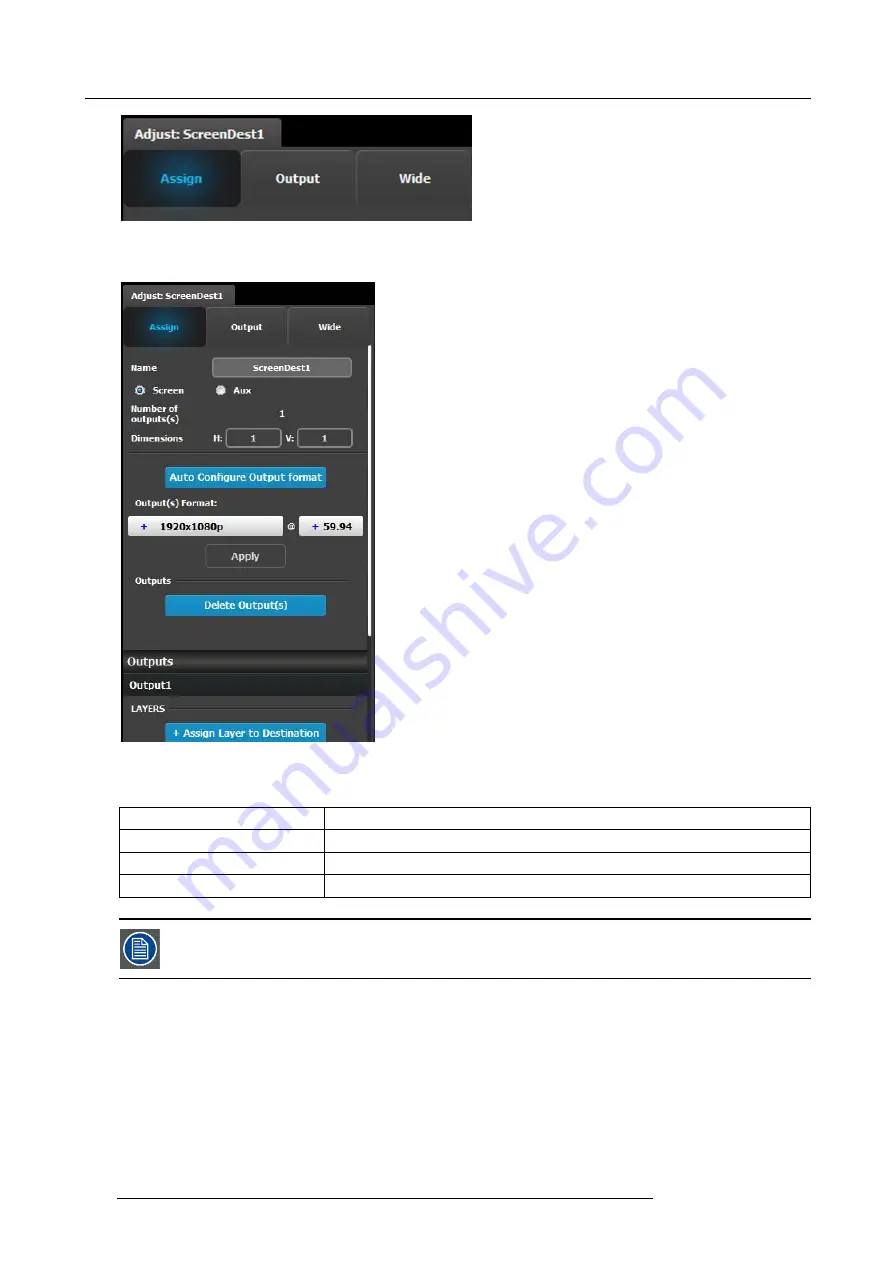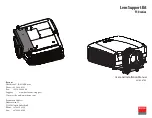
6. GUI orientation
•
Assign
•
Output
•
Wide
Assign Menu
•
Name: Adjusts the name of the Destination.
•
Destination type: Reports the type of destination Screen
or Aux. Can convert from Screen to Aux if it meets
requirements.
•
Number of output(s): Reports the number of output
con
fi
gurations in the destination.
•
Dimension: Adjust the output con
fi
guration layout .
•
Auto con
fi
gure Output format: Reads the EDID information
of the connected device to acquire its format. If more than
one device is connected to the destination, it reads the
format of the
fi
rst output. This feature is not available for
SDI outputs.
•
Output(s) format: Adjusts the output format of the
destination. This is applied to all outputs that are added into
this destination.
•
Outputs: Provides a list of the output con
fi
gurations
assigned to the Destination.
For Aux destinations, only 1 Output con
fi
guration is shown
or is allowed to be de
fi
ned. From this menu outputs can be
deleted or added as in the output con
fi
guration menu.
•
Layer (only applicable when Destination is a Screen). The
list shows the layers assigned to this Destination.
There are only sixteen 2K layers available in the system. Each “Assign Layer to Destination” uses 2 layer resources (as we are in
mix mode.) Therefore based on the Layer mode (set in the System Modi
fi
er Panel), the number of “Assign Layer to Destination”
varies. The table below shows the maximum number of mixable layer for each layer mode.
Layer Mode
Number of mixable layers
2K (Single link)
8
Dual Link
4
4K - UHD
2
Layers need to be assigned to destinations before sources can be added to the destination.
Output menu
The Output Menu contains 3 sub-menus:
Main
,
Color
and
Timing
. Adjustments in the Main and Timing menus are identical as in
the output con
fi
guration menu. In this menu, however, adjustments can be performed on all or on selected outputs that make up the
destination. Individual outputs can be selected by clicking on the corresponding screen. When a screen is selected its outline will
turn blue. All outputs can also be selected by clicking on the
Select All
button.
102
R5905948 E2 12/12/2014
Summary of Contents for Event Master E2
Page 1: ...E2 User s guide R5905948 00 12 12 2014...
Page 8: ...Table of contents 4 R5905948 E2 12 12 2014...
Page 16: ...2 Safety 12 R5905948 E2 12 12 2014...
Page 32: ...3 General 28 R5905948 E2 12 12 2014...
Page 82: ...6 GUI orientation Image 6 8 78 R5905948 E2 12 12 2014...
Page 94: ...6 GUI orientation Image 6 20 90 R5905948 E2 12 12 2014...
Page 115: ...6 GUI orientation Image 6 37 Thumbnail view Image 6 38 R5905948 E2 12 12 2014 111...
Page 186: ...7 System Setup 182 R5905948 E2 12 12 2014...
Page 192: ...8 Updating firmware 188 R5905948 E2 12 12 2014...
Page 196: ...9 General operation example Image 9 3 192 R5905948 E2 12 12 2014...
Page 213: ...9 General operation example Image 9 25 R5905948 E2 12 12 2014 209...
Page 216: ...9 General operation example 212 R5905948 E2 12 12 2014...
Page 220: ...10 Maintenance 10 2 Process Overview Flow chart Image 10 2 216 R5905948 E2 12 12 2014...
Page 281: ...10 Maintenance Disregard the heatsink from the spare kit R5905948 E2 12 12 2014 277...
Page 282: ...10 Maintenance 278 R5905948 E2 12 12 2014...
Page 288: ...11 Environmental information 284 R5905948 E2 12 12 2014...
Page 298: ...B Remote Control Protocol 294 R5905948 E2 12 12 2014...
Page 299: ...C Troubleshooting C TROUBLESHOOTING R5905948 E2 12 12 2014 295...
Page 300: ...C Troubleshooting 296 R5905948 E2 12 12 2014...
















































